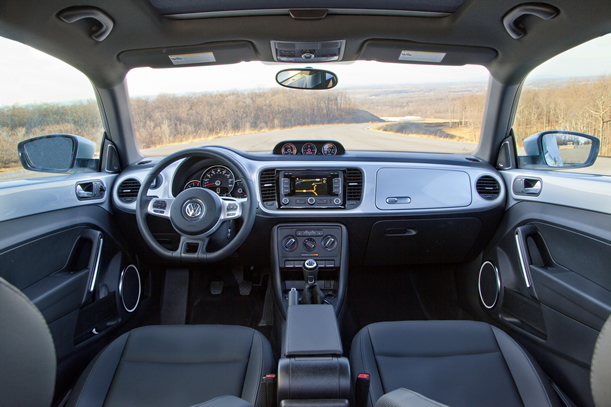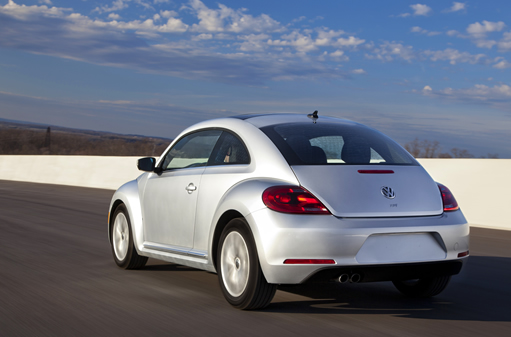For the 2013 model, two new Beetle special editions were introduced. The first was the Beetle Fender Edition. A marriage of icons from the worlds of music and the automobile, the Fender Edition stands out with unique interior and exterior styling. Its distinctively painted dashboard features the quintessential sunburst color of Fender guitars, and the vehicle’s interior is accented with color-contrasting seams that complement the dash’s colors. Outside, all Beetle Fender Edition vehicles are painted in Deep Black Metallic and also feature brushed chrome exterior mirrors, 18-inch “Disc” aluminum-alloy wheels, Bi-Xenon headlights, and the famous Fender logo. The package is available on 2.5L models with Sunroof and on Turbos with Sunroof and Sound.
Secondly, late in the model year, Volkswagen debuted the Beetle Turbo R-Line, replacing the Beetle Turbo with Sunroof, Sound, and Navigation. Externally, the R-Line model is differentiated by more aggressive front and rear bumpers, 19-inch “Tornado” aluminum-alloy wheels, R-Line badging, and Bi-Xenon headlights with LED DRLs.
Inside, the R-Line model features custom stainless-steel kickplates, a steering wheel badge, and a unique “chrome vanadium” dashboard panel. The base price for the Beetle Turbo R-Line is $30,135 when equipped with the six-speed manual transmission.
An icon, updated
The designers wanted to develop the latest Beetle around the profile of the earliest cars rather than the 1998 New Beetle. It’s a car that respects the past but looks toward the future.
Placing the original Beetle and the latest car next to one another, it’s clear that the lines of the rear sections are nearly identical, but the overall look is bolder and more dynamic. The Beetle also breaks free of the design geometry defined by three semi-circles—front fender, rear fender, and domed roof above it. The roof profile actually runs distinctly lower and can be considered a development of the Ragster concept car shown in Detroit in 2005. As a result, the new Beetle is bolder and more masculine.
“The Beetle is now characterized by a clean, self-confident and dominant sportiness. The car not only has a lower profile; it is also substantially wider, the front hood is longer, the front windshield is shifted further back and has a much steeper incline. All of this creates a new dynamism,” explains Volkswagen Brand Design Chief Klaus Bischoff.
The 2012 Beetle is 71.2 inches wide (3.3 inches wider), 58.5 inches tall (0.5 inches lower) and 168.4 inches long (7.4 inches longer) than the New Beetle. The new focal point is the C-pillar. The development team also increased the car’s track widths and wheelbase. The changed proportions give the Beetle a powerful and dynamic appearance.
A new feature is the rear spoiler that is standard on the 2.0 Turbo and is integrated into the design. The top surface of the rear spoiler is black, while the underside is painted in body color. Also, for the first time the Beetle is offered with Bi-Xenon headlights. These also serve as the daytime running lights and parking lights.
Interior
Klaus Bischoff characterizes the new Beetle’s interior thusly: “Its interior design is as unique as it is unmistakable, and very much a Beetle design, just like the car’s exterior styling.” The Beetle’s styling, ergonomics and quality interact to create a new, friendly car with a highly individual nature. The shape and use of color for the painted or carbon-look dashboards harkens back to the design of the first Beetle.

Three round gauges are arranged in front of the driver (tachometer, speedometer, fuel gauge), providing all key information at a glance. A multifunction display is integrated in the speedometer, which is housed in the central position in the binnacle. The steering wheel is specially designed with optional painted accents in the spokes depending on the equipment line.
Framed by two air vents, the audio/navigation system is optimally located in the driver’s field of vision on the dashboard. Within easy reach, the climate controls are situated just below. Similar to the original Beetle, the new car has an extra glovebox integrated into the dashboard—the kaeferfach or “Beetle bin”. The lid folds upward, while the standard glovebox opens downward. Another classic feature is the auxiliary instrumentation package sited above the audio/navigation system that consists of an oil temperature gauge, a clock with stopwatch function, and a boost pressure gauge. This is standard on Turbo and TDI models. For 2013, all Turbo models have a standard armrest.
Even though the “cathedral ceiling” dome roof of the New Beetle has been replaced with a sleek and sporty roofline, front and rear passenger headroom remains plentiful. The longer roof section results in 0.4 inches more rear-seat headroom. Front legroom is improved, too, by 1.9 inches, and front shoulder room grows by 2.5 inches. Overall, the interior volume has increased from 81 to 85 cubic feet.
The trunk is significantly larger, offering 15.4 cubic feet of space, compared with the New Beetle’s 12.0 cubic feet: with the seats folded, the capacity increases to 29.9 cubic feet. A split-folding rear seat—new on this Beetle—and a wide opening trunk lid ease loading and unloading.
Engines and Transmissions
The 2013 Beetle offers three engines and transmissions: the 2.5-liter five-cylinder engine mated to a five-speed manual or a six-speed automatic; and the 2.0-liter TDI turbocharged four-cylinder diesel and the 2.0-liter TSI® turbocharged four-cylinder engines with the acclaimed DSG® six-speed dual-clutch automatic or a six-speed manual.
The dual-overhead-cam, 20-valve, 2.5-liter inline five-cylinder engine makes 170 horsepower and 177 lb-ft of torque. Fuel economy values are improved by up to 10 percent over prior 2.5-liter models. When outfitted with the six-speed automatic transmission, the EPA estimated fuel economy rating is 22 mpg city and 29 mpg highway.
The dual-overhead-cam, 16-valve, 2.0-liter four-cylinder engine in the Turbo makes 210 horsepower and 207 lb-ft of torque, delivered from just 1700 rpm. With the DSG transmission, the Turbo gets manufacturer-estimated fuel economy of 24 mpg city and 30 mpg highway; for the Turbo with six-speed manual, the figures are 23 mpg city and 31 mpg highway.
The Beetle TDI uses the company’s 2.0-liter turbocharged, direct-injection Clean Diesel engine that makes 140 horsepower and 236 pound-feet of torque. The car has EPA estimated fuel economy of 28 mpg city and 41 mpg highway when equipped with the manual transmission and 29 mpg city and 39 mpg highway with the DSG.
Clean Diesel Leadership: Volkswagen pioneered the use of turbocharging and direct injection in diesel engines and continues to lead the industry in this technology. This isn’t the first Beetle to be sold in the U.S. market with a diesel engine. From 1998 until 2006, the New Beetle was fitted with a 1.9-liter turbocharged four-cylinder diesel engine.
Since then, this engine has been heavily revised to accommodate increasing demand for improvements in exhaust emissions and acoustics. One of the most fundamental improvements was converting the fuel-injection system to a common-rail design, as well as increasing the capacity by 72 cc thanks to a 1.5-mm wider bore.
The current engine features a cast-iron cylinder block and an aluminum-alloy cylinder head. It also utilizes some subtle design elements that contribute to longevity and the reduction of noise, vibration, and harshness. The forged steel crankshaft, for instance, uses just four counterweights, instead of eight, to reduce bearing load and noise emissions. The pistons incorporate annular channels into which oil is sprayed for cooling the piston-ring zone. A pair of counter-rotating balancer shafts is situated below the crankshaft in the oil pan.
Dual overhead camshafts are driven via a toothed belt that also powers the coolant pump and the high-pressure fuel-injection pump. The cams themselves are linked by means of spur gears that have an integrated backlash adjuster that helps to ensure quiet operation. Each cylinder has two intake and two exhaust valves.
The TDI engine’s intake manifold uses flap valves that are powered by a step motor that is in turn activated by the Engine Control Module (ECM). At idle and low engine speeds, the flap valves are closed in order to cause high swirl into the combustion chamber, which results in optimal mixture. During regular driving, the flap valves are adjusted continuously according to load and engine speed to ensure optimum air movement; above 3000 rpm, the valves open fully for maximum filling of the combustion chamber.
The engine’s turbocharger features adjustable guide vanes that maintain the best aspect ratio for low- and high-speed performance. In order to meet current tailpipe emissions standards in all 50 states, the engine makes use of both high- and low-pressure exhaust gas recirculation over all engine speeds, as well as an exhaust system that has a particulate filter and no fewer than three catalytic convertors: for oxidation, oxides of nitrogen (NOx), and hydrogen sulfide.
Dual-clutch transmission advantages: DSG combines the comfort and ease-of-use of an automatic with the responsiveness and economy of a manual. The six-speed, transversely-mounted DSG unit features two wet clutches with hydraulic pressure regulation. One clutch controls the “odd” gears—first, third, fifth and reverse—while the other operates the even gears. Essentially it is two gearboxes in one.
With DSG, the set-up allows the next-higher gear to be engaged but remain on standby until it is actually selected. In other words, if the Beetle is being driven in third gear, fourth is selected but not yet activated. As soon as the ideal shift point is reached, the clutch on the third-gear side opens, the other clutch closes and fourth gear engages under accurate electronic supervision.
Since the opening and closing actions of the two clutches overlap, a smooth gearshift results and the entire shift process is completed in less than four-hundredths of a second. In addition to its fully automatic shift mode, DSG has a Tiptronic® function to permit manual gear selection.
Suspension
All Beetle models are fitted with a strut-type front suspension with a lower control arm and an anti-roll bar: on the Beetle, this is 22 mm in diameter and is increased to 23 mm on the Turbo. The Beetle 2.5L and TDI models have a torsion beam rear suspension with coil springs and telescopic dampers. Turbo models get a multi-link independent rear suspension, with coil springs, telescopic dampers, and an 18-mm-diameter anti-roll bar.
All Beetle models have standard anti-lock brakes (ABS) with electronic brake pressure distribution (EBD). The Beetle has 11.3-inch-diameter vented front discs and 10.7-inch-diameter rear disc brakes. The Turbo has larger 12.3-inch-diameter vented front discs, with red calipers.
To help ensure that power is applied properly in challenging conditions, the Turbo model features the XDS® cross differential (limited-slip) system that electronically monitors input from various wheel sensors and, in the event of slippage, transfers extra torque to the wheel or wheels with the most traction
Safety and Security
The starting point in the Beetle’s safety armory is a very rigid body structure that uses ultra-high-strength, hot-formed steels in the crash-load paths and seamless laser welds. Electronic Stability Control (ESC) is standard. The Beetle includes Volkswagen’s advanced Intelligent Crash Response System that shuts off the fuel pump, unlocks the doors, and switches on the hazard lights if the car is involved in certain types of collision.
The Beetle is also covered under the no-charge Carefree Maintenance Program. All scheduled maintenance is covered for the length of the New Vehicle Warranty—three years or 36,000 miles, whichever occurs first. Additionally, all current Volkswagen vehicles use synthetic oil, which, when combined with state-of-the-art German engineering, eliminates the need for a 5000-mile oil change, and allows owners to go farther between scheduled oil changes.
 Asian Fortune Your source for all things Asian American
Asian Fortune Your source for all things Asian American

